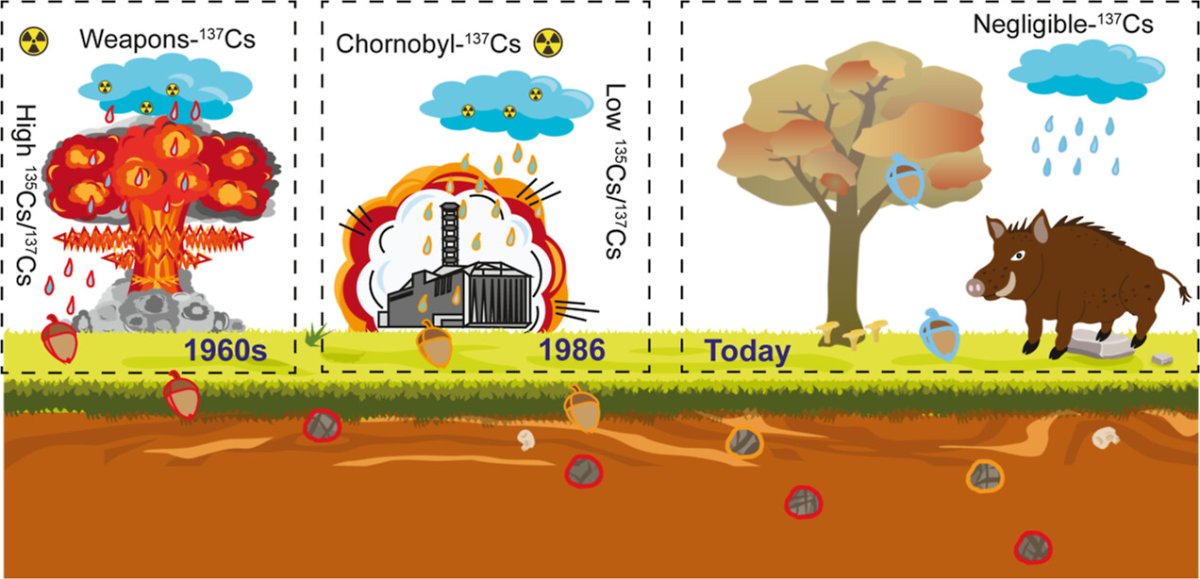Many of the wild boars roaming across central Europe are so radioactive that they are dangerous to eat, and it's down to a combination of nuclear weapons testing and the Chernobyl disaster.
Previously, their radioactivity was assumed to just be due to the 1986 Chernobyl nuclear power plant meltdown, but new research published in the journal Environmental Science & Technology has found that it may also largely be due to nuclear weapons testing.
"Our findings demonstrate that weapons-137Cs contributed between 12 and 68 percent in those samples that exceeded the regulatory limit," the authors wrote in the paper.
137Cs, or cesium-137, is a radioactive isotope of cesium produced during nuclear fission, which is the process of splitting an atom into two atoms of a different element. This process releases a huge amount of energy in the process, which is why fission is used in nuclear power plants and in nuclear weapons.

137Cs is a major product from the nuclear explosion tests of the mid-20th century and was released in large quantities from the Chernobyl and Fukushima nuclear accidents.
Thousands of nuclear weapons tests were carried out in the latter half of the 1900s: the United States carried out 1,054, most of which were in Nevada, with several hundred in the ocean and other states. The then-Soviet Union carried out 715 tests, mostly in now-Kazahkstan, while France tested weapons in the Saharah and atolls in the Pacific, and the United Kingdom did some tests in Australia. Many of these tests were atmospheric, meaning that the bomb was detonated above the ground and within the atmosphere.
Wild boars found across Bavaria in Germany have been found to contain 137Cs in such high levels that their meat is unsafe for human consumption. Strangely, although many animals have been found to contain 137Cs since Chernobyl, the levels of this isotope have been found to decrease in all but wild boars.

"However, unlike most forest species, which initially also exhibited high 137Cs contamination in their bodies followed by a decline with time (i.e., a short ecological half-life), 137Cs levels in wild boars have not shown a significant decline trend since 1986," the authors wrote.
This phenomenon has been named the "wild boar paradox."
One explanation is that the boars are ingesting 137Cs via truffle fungus in their diet that accumulates 137Cs from the soil. However, exactly how the 137Cs got into the soil has remained a mystery until now.
The authors of the paper explain how they tested samples of boar meat for both 137Cs and 135Cs, a much longer-lived cesium isotope also produced by nuclear fission, but produced in much greater quantities in nuclear explosions than in nuclear power plants.
"A nuclear explosion hence yields a relatively high 135Cs/137Cs ratio, whereas a reactor yields a low ratio," they explain in the paper.

This finding is significant, as until now, the cesium released by nuclear weapons testing has been considered to be much smaller compared to that from Chernobyl.
"Contribution [of weapons-137Cs] as a pollutant of central Europe has generally been regarded as negligible compared to that of Chernobyl, our work provides the forensic evidence showing that this underestimated 137Cs legacy can accumulate in certain environmental media along with more recent reactor-137Cs releases," the authors wrote.
They note that future nuclear accidents or explosions could worsen these animals' contamination, potentially impacting food safety for decades.
"This study illustrates that strategic decisions to conduct atmospheric nuclear tests 60–80 years ago still impact remote natural environments, wildlife, and a human food source today," they wrote in the paper.
Do you have a tip on a science story that Newsweek should be covering? Do you have a question about nuclear isotopes? Let us know via science@newsweek.com.
Uncommon Knowledge
Newsweek is committed to challenging conventional wisdom and finding connections in the search for common ground.
Newsweek is committed to challenging conventional wisdom and finding connections in the search for common ground.
About the writer
Jess Thomson is a Newsweek Science Reporter based in London UK. Her focus is reporting on science, technology and healthcare. ... Read more
To read how Newsweek uses AI as a newsroom tool, Click here.








